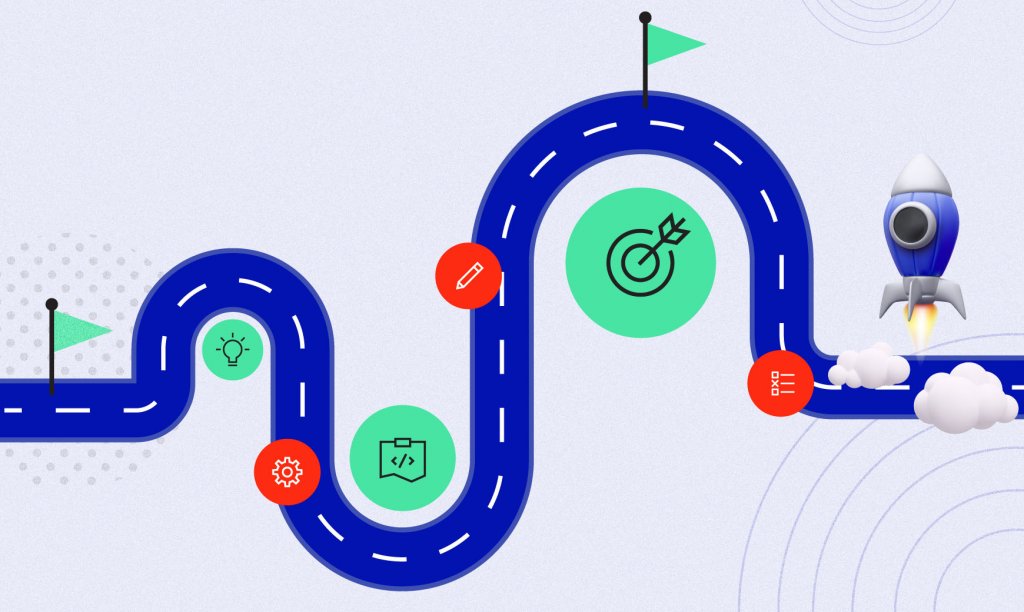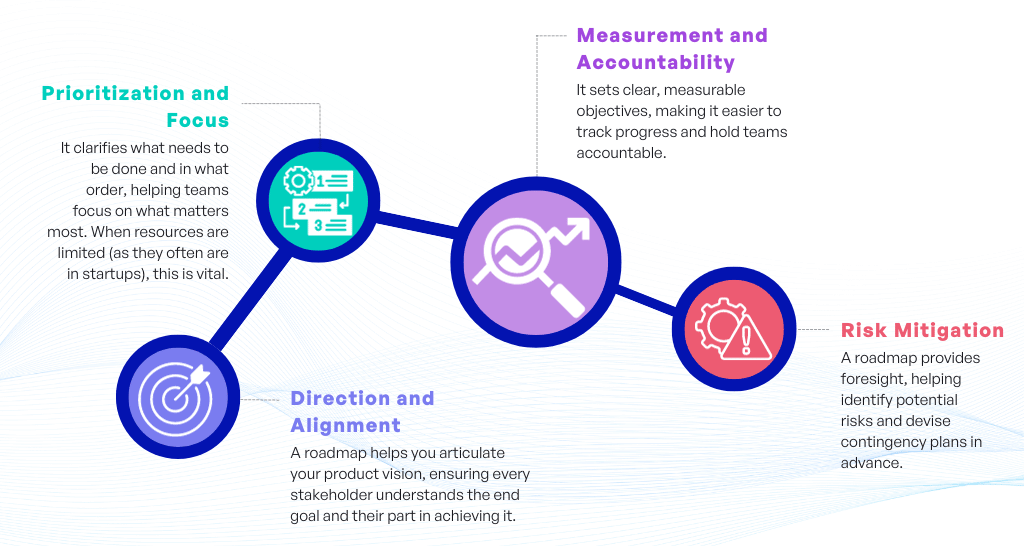
1. Why a Product Roadmap is Crucial for Startup Growth?
So, you’ve got an idea for a game-changing product or service – it’s transformative, innovative, and could potentially disrupt the market. Fantastic! But now, how do you move from ideation to execution? How do you ensure your vision translates smoothly into reality? Enter the product roadmap.
1.1. What is a Product Roadmap?
Before we delve deeper, let’s first define what we mean by a ‘product roadmap’. A product roadmap is essentially your game plan, a strategic document that outlines the direction, priorities, and progress of your product over time. It’s a visual representation that aligns your stakeholders – customers, investors, team members – around your product vision and how you plan to bring it to life.
1.2. Why is a Product Roadmap Crucial?
Now, let’s dissect why a product roadmap is so crucial, especially for startups. Wondering why you can’t just wing it? Here are a few reasons:

Moreover, a clear, detailed product roadmap can be a compelling tool to attract investors. As a startup founder, you know that securing funding is a critical part of the journey – and presenting a thoughtful, well-constructed roadmap can be a strong testament to your strategic thinking and management skills.
2. Key Elements to Include in Your Product Roadmap
Developing an effective product roadmap is a bit like assembling a jigsaw puzzle. It requires carefully piecing together various elements, each vital to the overall picture. But rest assured, the effort you put into assembling this puzzle will pay off handsomely in the long run. So, what elements should you include in your roadmap to ensure success?
2.1. Prioritized Features
The first key component of a product roadmap is a list of prioritized features. These are the core functionalities of your product that will provide the most value to your target audience. But how do you decide which features to prioritize? This is where customer input comes into play. By seeking feedback from your target users, you can better understand their needs and create a product that truly meets these needs. This is not only good for customer satisfaction but can also give you a competitive edge.

2.2. Clearly Defined Goals
Another crucial part of your roadmap should be clearly defined goals. These will provide direction for your team and can keep everyone aligned toward a shared vision for your product. Remember, a roadmap without a destination is just a map. So, ensure these goals are SMART – Specific, Measurable, Achievable, Relevant, and Time-Bound.
2.3. Timelines
Let’s not forget about timelines, every successful roadmap includes a realistic and flexible timeline. While it’s imperative to keep your tears on their toes, setting unrealistic timelines can cause undue stress and lead to burnout. Be clear on this: a roadmap is NOT a project management tool. It should provide a rough idea of timelines, not a day-to-day schedule.
2.4. Resources Needed
It’s also critical to outline the resources needed for each phase of your product’s journey. This includes not only financial resources but also the personnel, technology, and infrastructure required. Providing this information helps everyone clearly see what’s needed to make your product a reality, thus eliminating any potential misunderstandings or miscommunications.
2.5. Scope for Flexibility
Last but not least, your product roadmap should include room for flexibility. In a startup environment, changes are inevitable. Markets shift, customer preferences evolve, and new opportunities arise. Therefore, your roadmap must be able to accommodate these changes and pivot as necessary.
In a nutshell, a comprehensive product roadmap should include prioritized features, clearly defined goals, realistic timelines, required resources, and scope for flexibility. Equipped with this, you can navigate your startup through the maze of product development with greater confidence and clarity.
3. Example of product roadmap
For a clearer understanding, let’s look at how a product roadmap might be structured. Imagine you’re an entrepreneur who aims to launch a revolutionary travel app that helps users easily plan and manage their trips.
| Timeline | Prioritized Features | Goals | Resources |
| Quarter 1 | – User registration and profile setup – Basic trip planning (dates, locations) | Release the MVP to get initial user feedback | – In-app messaging – Collaborative trip planning |
| Quarter 2 | – In-app messaging – Collaborative trip planning | Increase user engagement and onboard new users | – Mobile developers – Marketing and customer acquisition specialists |
| Quarter 3 | – Integration with travel-related services (hotels, flights) | Increase monetization and improve the trip Planning experience | – Strategic partnerships manager – Data analyst |
This scenario is just for illustration. Each product’s roadmap will be different based on the unique nature of the product, team, and market dynamics. However, the fundamental elements remain the same – strategic goals, clear timelines, identified necessary resources, and prioritized features.
Later in this article, we’ll delve into the specifics of each of these elements. Also, while this example is quite rigid, remember, that most startups will also need to adopt a level of flexibility in their roadmap, something we’ll explore further down the line.
4. Trends and Emerging Practices
As we navigate toward an increasingly dynamic and digital world, the practices surrounding product roadmapping are also evolving. By staying ahead of these trends, you can ensure that your startup not only survives but thrives in the competitive sphere.
4.1. Trend #1: Data-Driven Decision Making
Modern startups are leveraging data like never before. Relying solely on gut feelings or anecdotal evidence when building your product roadmap can be risky. Instead, smart startups are using data to make informed decisions about what features to prioritize, how long tasks should take, and where resources are most needed. This shift towards data-driven decision-making is expected to become increasingly prevalent in the future.
4.2. Trend #2: Agile Roadmapping
Another trending practice is the use of agile roadmaps. As the name suggests, this strategy is centered around adaptability. Traditional roadmaps can often be rigid, but in an ever-changing business environment, flexibility is key. Agile roadmaps allow for adjustments along the way, reducing the risks associated with sticking to a fixed plan and allowing your business to pivot as necessary.
4.3. Trend #3: Virtual Collaboration
In today’s interconnected world, collaboration is not bound by geography. More and more startups are assembling diverse teams scattered around the globe. This trend is reflected in modern product roadmap tools, which offer features like real-time collaboration, feedback loops, and virtual whiteboarding. These innovations allow teams to work together seamlessly, irrespective of their physical location.

4.4. Trend #4: Customer-Centric Roadmaps
Finally, there’s a widening focus on creating customer-centric roadmaps. After all, what good is a beautiful product if it doesn’t meet the needs of your users? Instead of building products based solely on internal objectives and insights, the trend is now to incorporate more user feedback into the roadmap process. This ensures that the product evolves in line with actual user needs and expectations, setting the stage for greater customer satisfaction and improved market performance.
In conclusion, product roadmapping is not a static process; it’s dynamic, adapting, and evolving with the times and trends. By being aware and proactive in incorporating these trends into your product roadmap strategy, you stand a better chance of creating products that not only resonate with your target audience but also stand the test of time. So keep an eye on these trends and practices, and let them guide you toward a more fruitful future.
5. Conclusion: Embracing the Power of a Well-Crafted Product Roadmap
As we reach the end of this contemplative journey together, it’s clear: a well-crafted product roadmap isn’t simply a nice-to-have. It’s an instrumental tool shaping the course of your startup’s growth and development. Effective road mapping encourages strategic thinking, enhances team communication, and illuminates the pathway toward your ultimate business vision.
But remember – you’re not merely creating a document. You’re building a strategic guide, a beacon that’ll light the path for your team amidst the often challenging, sometimes turbulent, voyage of a startup-founder. So, embrace the power of a well-crafted product roadmap, for it is far more than a chart – it’s your strategic compass.
Yet, as you draft this blueprint, don’t forget inclusion, flexibility, and adaptability remain your allies. The world of startups is anything but static – and neither should be your roadmap. Adapt your strategy as needed, based on new insights, metrics, and feedback. Incorporate trends like data-driven decision-making, agile road mapping, and customer-centricity, to stay relevant and competitive.
Ultimately, a good product roadmap helps you to be proactive rather than reactive. Taking the time to plan carefully today can save you countless hours of course correction tomorrow. So, consider the roadmap your key to unlocking a future marked by innovation, growth, and continued success. Aren’t these what every entrepreneur dreams of?
Here’s to your journey. Here’s to your product roadmap. Start creating it today, and watch how your startup flourishes tomorrow.
If you have any questions about product development, feel free to contact KVY TECH!


